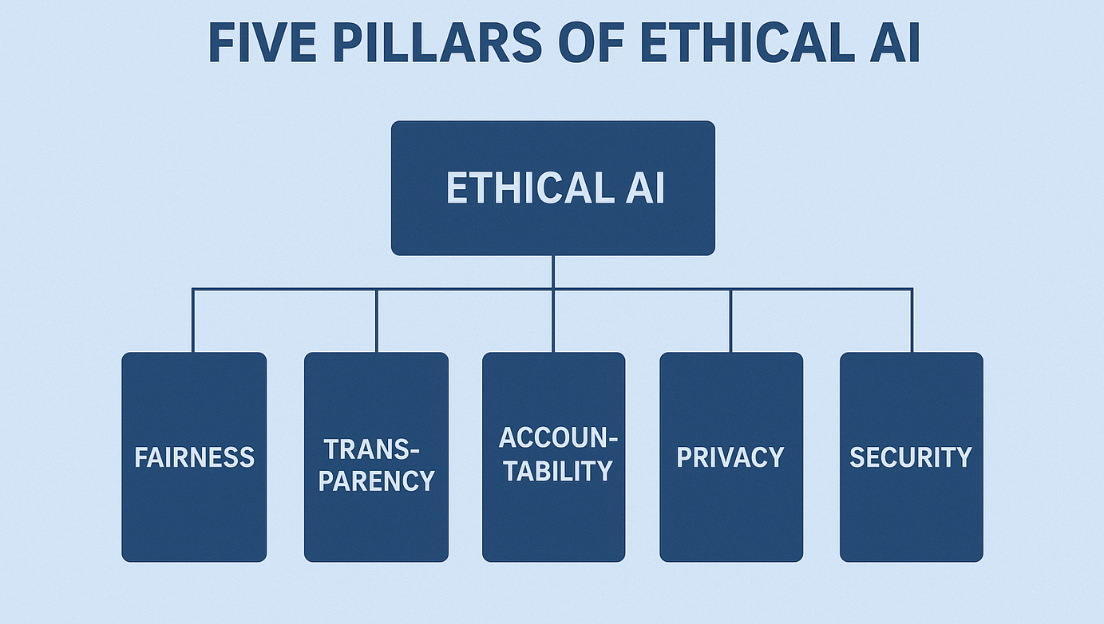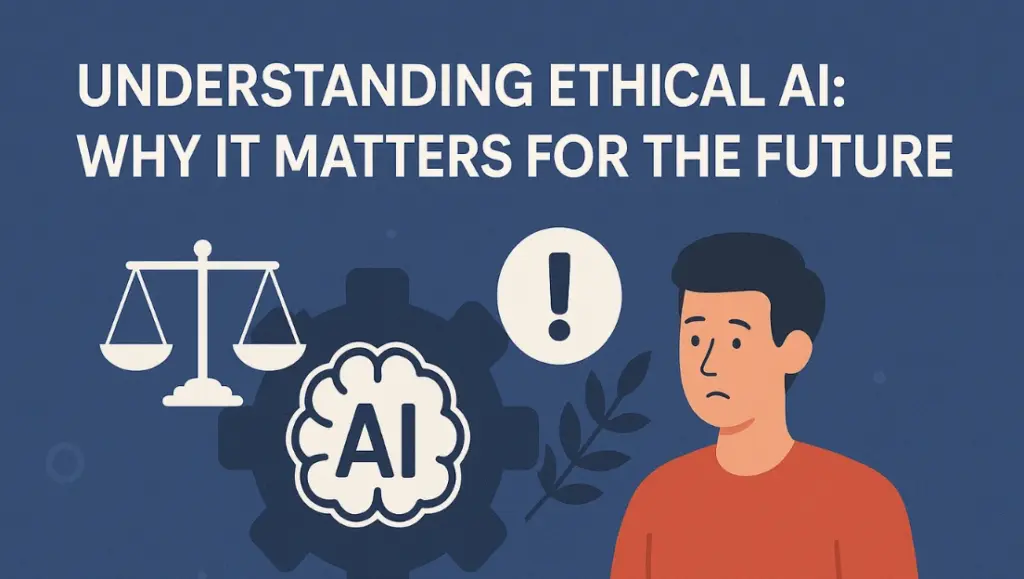Introduction: Why We Need Ethical AI Now More Than Ever
Artificial intelligence (AI) is no longer a futuristic concept — it’s an integral part of daily life, from voice assistants and recommendation engines to healthcare diagnostics and autonomous vehicles. However, as AI systems become more powerful and embedded in society, questions surrounding ethical AI and its importance are more urgent than ever. What happens when algorithms make decisions that affect people’s lives? Who is accountable? And how do we ensure fairness and transparency?
This article explores the foundational principles of ethical AI, global policy trends, challenges like bias and lack of accountability, and what developers, businesses, and policymakers can do to ensure a responsible AI-driven future.
What Is Ethical AI?
Ethical AI refers to the design, development, and deployment of artificial intelligence systems in ways that align with moral values and social good. It emphasizes principles like:
- Transparency – How AI makes decisions should be explainable.
- Fairness – Avoiding biases and ensuring equality.
- Accountability – Clear responsibility for AI outcomes.
- Privacy – Respecting user data and consent.
- Safety and Reliability – Ensuring AI systems perform as intended.
These principles aim to mitigate harm and maximize societal benefit.
“Ethical AI is not a luxury — it’s a necessity in building trust between humans and machines.”

The Rise of Responsible AI Development
With increasing reliance on machine learning models in critical sectors like finance, healthcare, and law enforcement, responsible AI development has gained momentum. Leading organizations and governments are creating AI ethics frameworks and advisory boards.
For example:
- Google, headquartered in California, published its AI principles in 2018, promising not to develop AI for weapons or surveillance.
- OpenAI commits to ensuring AGI (Artificial General Intelligence) benefits all of humanity.
- Microsoft has established an AI, Ethics, and Effects in Engineering and Research (Aether) Committee.
These initiatives signal a growing understanding that technology must serve society — not the other way around.
Understanding the Consequences: Bias in AI Algorithms
One of the most pressing concerns around ethical AI is bias. Machine learning models are trained on data — and data reflects human history, with all its imperfections. If unchecked, this can lead to discriminatory outcomes:
- Facial recognition systems performing poorly on darker skin tones.
- Hiring algorithms filtering out women and minority applicants.
- Predictive policing tools disproportionately targeting certain communities.
How Can We Reduce Bias in AI?
- Diverse and representative training data
- Regular audits for algorithmic fairness
- Involving ethicists and marginalized voices during development
Ethical AI mandates that inclusivity be built into the system — not added as an afterthought.
Global Frameworks for Ethical AI: EU, OECD, and Beyond
To ensure AI is governed responsibly, international bodies have introduced formal ethics guidelines. Notable among them:
1. EU’s AI Act
- First-of-its-kind regulation classifying AI systems by risk level.
- Prohibits certain harmful practices (like social scoring).
- Requires transparency, human oversight, and documentation.
2. OECD AI Principles
- Endorsed by 46 countries.
- Advocates for inclusive growth, human-centered values, and accountability.
3. UNESCO’s AI Ethics Recommendation
- Promotes AI systems that uphold human rights, environmental sustainability, and gender equality.
These frameworks provide benchmarks for developers and governments, urging ethical design and oversight.
The Role of California-Based Tech Giants in Shaping AI Ethics
As the home of Silicon Valley, California plays a pivotal role in the global AI landscape. Companies like Google, Apple, Meta (Facebook), and OpenAI are not only developing cutting-edge AI but also helping define what ethical AI looks like in practice.
- OpenAI’s ChatGPT includes safety layers to filter harmful content.
- Meta has invested in explainable AI (XAI) research to improve algorithm transparency.
- Apple incorporates on-device AI to protect user privacy.
Their global influence means that decisions made in California reverberate worldwide, setting ethical norms across industries.
Why Ethical Implications of Artificial Intelligence Matter
Let’s be clear: AI isn’t inherently good or bad — it’s a tool. But like any powerful tool, its use must be governed by intent and care.
The ethical implications of artificial intelligence include:
- Manipulation of human behavior (e.g., deepfakes, microtargeted ads)
- Loss of autonomy (decisions made by opaque algorithms)
- Economic displacement (automation without reskilling workers)
To counteract these challenges, ethical AI provides a moral compass that aligns innovation with public good.
Building AI Fairness and Accountability into Systems
Fairness and accountability are two pillars of trustworthy AI. But how can they be practically implemented?
Strategies to ensure fairness:
- Use counterfactual fairness techniques in model design.
- Simulate different demographic outcomes during testing.
Ensuring accountability:
- Maintain model cards and data sheets for transparency.
- Establish human-in-the-loop review processes.
- Provide grievance redressal channels for affected users.
These aren’t just technical fixes — they require cultural and organizational commitment.
AI Transparency and Explainability: Why They Matter
Imagine being denied a loan by an AI — and not knowing why. This is the risk of black-box systems.
Benefits of transparent AI:
- Builds public trust in AI systems.
- Enhances legal compliance (especially in sectors like finance).
- Facilitates debugging and improvement by developers.
Explainability tools like LIME, SHAP, and interpretML are helping decode complex models. The push for transparency isn’t just good ethics — it’s good business.
The Future of Ethical AI: Trends to Watch
As AI matures, ethical AI will evolve in several ways:
- AI ethics embedded in education: More universities are introducing AI ethics courses for engineers.
- Ethics-as-a-Service platforms: Tools that scan for bias and compliance before deployment.
- Cross-border collaboration: Nations working together on interoperable AI standards.
In short, the future of ethical AI is collaborative, proactive, and values-driven.
FAQs on Ethical AI
Q1: Why is ethical AI important?
A: Ethical AI ensures that technology benefits all of society without harming vulnerable groups. It promotes fairness, trust, and accountability in how AI is used.
Q2: How can AI be developed responsibly?
A: Responsible AI development involves transparency, bias mitigation, inclusive design, and ongoing monitoring of AI outcomes.
Q3: What is the EU AI Act?
A: The EU AI Act is a regulatory framework introduced by the European Union to categorize AI systems by risk and ensure human oversight and accountability.
Q4: How do tech companies address AI ethics?
A: Companies implement ethics committees, develop internal guidelines, and integrate fairness tools to evaluate their AI systems.
Q5: What role does California play in global AI ethics?
A: As the epicenter of major tech firms, California sets trends in ethical AI practices through innovation, policy experimentation, and leadership in AI governance.
Conclusion: Ethical AI is Everyone’s Responsibility
Ethical AI is not a checkbox — it’s a continuous process involving developers, companies, governments, and citizens. By building systems that are fair, transparent, and accountable, we ensure AI enhances human potential rather than undermines it.
Learn how your organization can integrate ethical AI practices into development and deployment. Explore global standards and create a responsible future with AI.
